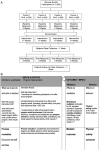An overview of "The Active by Choice Today" (ACT) trial for increasing physical activity
- PMID: 17716952
- PMCID: PMC2830072
- DOI: 10.1016/j.cct.2007.07.001
An overview of "The Active by Choice Today" (ACT) trial for increasing physical activity
Abstract
Background: Although school-based behavioral interventions for increasing physical activity (PA) in children and adolescents have been conducted, little evidence suggests that these curriculum-based approaches lead to increases in overall activity outside of program days. The overall goal of the "Active by Choice Today" (ACT) trial is to expand the body of knowledge concerning the factors that influence long-term increases in PA in underserved adolescents (low socioeconomic status, minorities) during their middle school years.
Design and setting: An overview of the ACT study design, theoretical framework, process evaluation, and primary hypotheses is presented. The trial involves twenty-four middle schools (1560 6th graders) in South Carolina that are randomly assigned to one of two after-school programs (motivational and life skills intervention, or general health education).
Intervention: The intervention integrates constructs from Self-Determination and Social Cognitive Theories to enhance intrinsic motivation and behavioral skills for PA. The intervention targets skill development for PA outside of program days and the after-school program social environment (autonomy, choice, participation, belongingness, fun, enjoyment, support) is designed to positively impact cognitive mediators (self-efficacy, perceived competence), and motivational orientation (intrinsic motivation, commitment, positive self-concept). MAIN HYPOTHESES/OUTCOMES: It is hypothesized that the 17-week motivational and life skills intervention will lead to greater increases in moderate-to-vigorous PA (based on 7-day accelerometry estimates) at post-intervention as compared to the general health education program.
Conclusions: Implications of this innovative school-based trial are discussed.
Figures
References
-
- Wilson DK, Kitzman-Ulrich H. Cultural considerations in the development of pediatric weight management programs. In: Jelalian E, editor. Handbook of childhood obesity. American Psychological Association; Washington, DC: in press.
-
- Sallis JF, Zakarian JM, Hovell MF, et al. Ethnic, socioeconomic, and sex differences in physical activity among adolescents. J Clin Epidemiol. 1996;49:125–34. - PubMed
-
- Bungum TJ, Vincent ML. The parental modeling questionnaire. Am J Prev Med. 1997;13:115–22. - PubMed
-
- Baranowski T, Anderson C, Carmack C. Mediating variable framework in physical activity interventions. How are we doing? How might we do better? Am J Prev Med. 1998;15:266–97. - PubMed
-
- Gortmaker SL, et al. Reducing obesity via a school-based interdisciplinary intervention among youth: planet health. Arch Pediatr Adolesc Med. 1999;153:409–18. - PubMed


